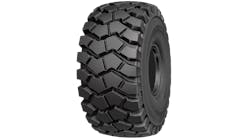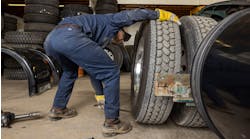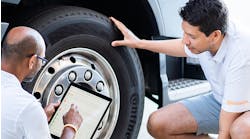AG Tire Talk: Tire Inflation Systems Will Keep Farmers Rolling
Question: Do you foresee variable air pressure systems becoming popular on U.S. agricultural equipment? If so, how is tire performance affected, and what yield, traction and transport benefits can growers expect to receive?
David Graden, operational agriculture market manager, Michelin North America Inc.: Variable air pressure systems allow a machine operator to adjust tire inflation with the simple touch of a button to optimize operational efficiency between field and road based upon preset parameters. This type of system will absolutely become more and more popular in the near future, as it will ultimately provide a combination of superior traction with the lowest possible soil compaction while in field.
In fact, Michelin is one of many companies investing in variable air pressure systems through the acquisition of two leading tire inflation system companies, PTG (PTG Reifendruckregelsysteme GmbH) and Teleflow S.A.S. (Michelin purchased the two companies in 2017.) Michelin has also successfully invented and launched the EvoBib to specifically work with tire inflation systems. The Michelin EvoBib, a “2-in-1 tire,” was created with a patented tread pattern and casing technology that allows it to change its footprint and profile more than 20% and increase traction up to 50%, according to the inflation pressure.
Very soon, I imagine we will see variable air pressure systems becoming fully automated so operators won’t even have to press a button. These systems will also close the traction gap between tires and tracks dramatically, at a significantly lower cost.
James Crouch, marketing specialist, Alliance Tire Americas Inc.: Variable air pressure systems, or CTIS (Central Tire Inflation Systems), will almost certainly gain popularity in the U.S. market. They are already becoming common in the European market and are being offered directly from the OEMs. The reasons for their increase in popularity and inevitable acceptance span from increased fuel efficiency to reduced soil compaction, but ultimately all the benefits revolve around operating a tire at the exact correct pressure for the load and speed imposed on the tire.
The challenge for ag tires without CTIS is that they are almost always over-inflated out of necessity and safety.
For example, consider a MFWD (mechanical front-wheel drive) tractor on duals pulling a center-fold planter. This machine will travel to the field at 25+ mph, but only move at 6 to 9 mph once it gets in the field.
In this example, the rear tires on the MFWD would likely need to be set at 35 psi for safety when hauling the folded planter down the road. When the rig gets into the field, the pressures could be reduced to 10 to 14 psi because the full load from the planter would no longer be imposed on the rear axle and the speed would be dramatically reduced.
But in reality, very few farmers are going to take the time to get out of the machine and reduce the air in their tires once they pull into the field. This time-consuming task would be completed automatically with a CTIS system.
Dave Paulk, manager of field technical services, BKT USA Inc.: I do see variable air pressure systems becoming more commonplace on equipment as the prices get more affordable. They are expensive to buy and install, but should pay for themselves over the life of a high horsepower tractor. Maintaining correct air pressure is so important to ensuring that all the right things happen with a tire.
Most tractors that would use a variable air system would use radial tires. Radial tires require a better air management program than bias-ply tires do. Various tests have shown that incorrect air pressure can waste 20% to 40% engine power through slip and increased rolling resistance. Incorrect air pressures can also lead to power hop problems.
By using variable air systems, this ensures that the tires maintain correct air pressures without the need to continuously check air pressures.
Scott Sloan, ag product manager/global LSW, Titan International Inc.: I do believe we will begin to see more and more onboard inflation systems showing up in the U.S. in the next five years. As precision farming presses on from the science of the seed, application and condition standpoint, growers are going to be looking for other opportunities to improve machine performance.
As tire technology has evolved with deflection technologies like IF and VF, it has enabled growers to run at lower inflations up to 40% lower.
However, inflation pressure for transport may be different than inflation in the field. Growers will not get out of their machine to drop inflation pressures for 20 minutes to operate in the field, then re-inflate for another 30 when they get back on the road. Knowing this, we as the tire industry educate them to inflate the tire for the worst case scenario. This eliminates the possibility of damaging the tire due to an overloaded and underinflated condition. By doing this the grower is giving up footprint area in lighter conditions such as planting, which may hinder the yield.
The idea of the onboard inflation system is that it allows the grower to easily and relatively quickly adjust the inflation pressures in the tires from the comforts of the cab. This then allows them to maximize the tire’s footprint based on the load for each individual task, hence reducing compaction and potentially increasing yields.
Cost, however, is still a hindrance for the technology. Aftermarket systems are approximately $15,000, and at $3 corn the decision to pull the trigger on the system relies greatly on that customer’s idea of the chances of them recouping their cost in additional revenue.
Bradley Harris, manager of global agricultural field engineering, Firestone Ag Division, Bridgestone Americas Tire Operations LLC: Yes, central tire inflation pressure systems (CTIS) will become more popular on agricultural equipment in the future. When properly used, these systems can lead to improved traction in the field and reduced soil compaction, which can improve crop yields. These systems allow farmers to quickly manage the inflation pressure in the tires when the axle weights on equipment changes between field and the road. This is why CTIS systems are becoming popular in Europe.
A CTIS system makes sense for tractors when the axle weight changes between road transportation and field operation. The most common scenario in North America would be the planter tractor with a 2-point mounted, front fold planter. During road transport, the planter wings fold forward and the planter weight is carried on the rear axle of the tractor and only four tires on the planter. Weighing a 235 horsepower MFWD tractor with a 16/32-inch row front fold planter, the rear axle weight of the tractor is around 27,000 pounds during road transport. When the planter is unfolded in the field, the weight of the planter is now taken off the rear of the tractor and is being carried primarily by the eight tires on the planter. Now the rear axle weight of the tractor is 16,500 pounds. With dual 480/80R50 tires on the rear of the tractor, the farmer would need to set the inflation pressure to 23 psi to carry the 27,000 pounds for road transport. When the tractor is the field, 23 psi is an overinflated condition to carry the 16,500 pounds. Having the higher inflation pressure will not damage the tire, but it does reduce the tire’s footprint. With a smaller footprint, the tire cannot fully transmit power to the ground. This reduces traction in the field and increases fuel consumption.
With a CTIS system the farmer could inflate the rear tires on the tractor to 23 psi on the road, and when they get to the field the inflation pressure could be easily lowered to 12 psi. This would give the farmer the optimal footprint and all the tire to generate the maximum traction.
Norberto Herbener, OE applications engineer, Trelleborg Wheel Systems Americas Inc.: Because farmers are concerned about reducing soil compaction and increasing their equipment’s effectiveness, maintaining the right tire inflation pressure is a must. The good news is that tires have evolved a great deal, technologically speaking, and behave according to their construction (design), inflation pressure, applied load and working speed in an interconnected way. If set up correctly, tires will perform as expected.
The first step is knowing the load or weight the tires will carry and the speed that will be used to carry that load. With this information farmers can adjust the inflation pressure to gain the highest tire efficiency. What are the goals? The largest footprint for the lowest compaction, with the lowest slippage (due to more lugs being on the ground). Balancing floatation and grip are key. While this sounds easy, with constant changes to the loads and speed of farm equipment, it isn’t. This is where variable inflation systems come into play and will become the future standard. Many equipment manufacturers are collaborating with tire manufacturers on central tire inflation systems (CTIS).
The next evolutionary step is a constant monitoring and changing air pressure system adapting to load and speed changes in real time and inflating or deflating tires as needed. Imagine a combine with the grain bin filling, unloading and changing speed depending on the local yield. In this direction Trelleborg presented the VIP System (awarded the Gold Medal for Innovation at the 2017 SIMA Show in Paris, France). This self-contained system continually monitors load changes and adjusts tire inflation pressure by using its own compressor, mounted on the tire hub, to maintain the correct pressure, largest footprint, lowest soil compaction and best traction possible.
This system reduces fuel consumption, slippage and working time, while saving the farmer from checking air pressure constantly and allowing for better crop conditions and yield.
As an additional benefit, using the tires under the conditions for which they were designed will help them suffer less stress and last longer, as they will be used at their peak performance capacity. ■
James Tuschner, founder of AG Tire Talk, is a 25-year tire industry veteran.



